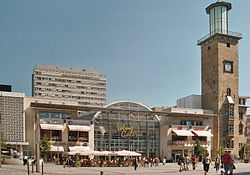Hengstey
| Hagen | |||
|---|---|---|---|

Old Town Hall (right) and Square. In the center the Volme Galerie (City Mall).
|
|||
|
|||
| Coordinates: 51°22′N 7°29′E / 51.367°N 7.483°ECoordinates: 51°22′N 7°29′E / 51.367°N 7.483°E | |||
| Country | Germany | ||
| State | North Rhine-Westphalia | ||
| Admin. region | Arnsberg | ||
| District | Urban districts of Germany | ||
| Government | |||
| • Lord Mayor | Erik O. Schulz (independent) | ||
| Area | |||
| • Total | 160.4 km2 (61.9 sq mi) | ||
| Elevation | 106 m (348 ft) | ||
| Population (2015-12-31) | |||
| • Total | 189,044 | ||
| • Density | 1,200/km2 (3,100/sq mi) | ||
| Time zone | CET/CEST (UTC+1/+2) | ||
| Postal codes | 58000-58139 | ||
| Dialling codes | 02331, 02334, 02337 | ||
| Vehicle registration | HA | ||
| Website | www.hagen.de | ||
Hagen (German pronunciation: [ˈhaːɡn̩]) is the 41st-largest city in Germany. The municipality is located in the state of North Rhine-Westphalia. It is located on the south eastern edge of the Ruhr area, 15 km south of Dortmund, where the rivers Lenne and Volme (met by the river Ennepe) meet the river Ruhr. As of 31 December 2010, the population was 188,529. The city is home to the FernUniversität Hagen, which is the only state funded distance education university in Germany. Counting more than 67,000 students (March 2010), it is the largest university in Germany.
Hagen was first mentioned c.1200, presumably the name of a farm at the junction of the Volme and the Ennepe. After the conquest of Burg Volmarstein in 1324, Hagen passed to the County of Mark. In 1614 it was awarded to the Margraviate of Brandenburg according to the Treaty of Xanten. In 1701 it became part of the Kingdom of Prussia.
After the defeat of Prussia in the Fourth Coalition, Hagen was incorporated into the Grand Duchy of Berg from 1807–13. In 1815 it became part of the new Prussian Province of Westphalia.
The growth of the city began in the 19th century with the mining of coal and the production of steel in the Ruhr Area. Hagen was the scene of fighting during the Ruhr Uprising, 13 March - 2 April 1920 and has a monument to the Ruhr Red Army.
...
Wikipedia



